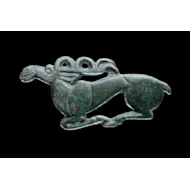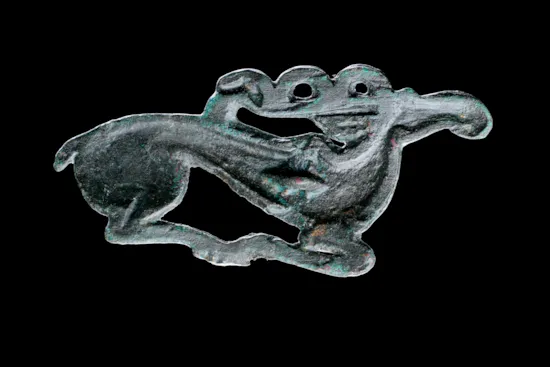Ancient Bronze Age South Siberian Scythian Tagar Amuletic Cast Bronze Stylised Recumbent Stag Plaque
An Ancient Bronze Age South Siberian Scythian Tagar Amuletic Cast Bronze Stylised Recumbent Stag Plaque
The reverse with single attachment loop
Old smooth greenish black patina
Circa 5th Century B.C
Size: 5cm high, 10cm wide - 2 ins high, 4 ins wide
The reverse with single attachment loop
Old smooth greenish black patina
Circa 5th Century B.C
Size: 5cm high, 10cm wide - 2 ins high, 4 ins wide
An Ancient Bronze Age South Siberian Scythian Tagar Amuletic Cast Bronze Stylised Recumbent Stag Plaque
The reverse with single attachment loop
Old smooth greenish black patina
Circa 5th Century B.C
Size: 5cm high, 10cm wide - 2 ins high, 4 ins wide
The reverse with single attachment loop
Old smooth greenish black patina
Circa 5th Century B.C
Size: 5cm high, 10cm wide - 2 ins high, 4 ins wide
These small plaques of stags were probably used as clothing attachments for belts or horse bridles whilst the bigger images were used as the central ornaments on war shields. Predominantly of bronze, they are typical of the Steppes art of the Scytho-Siberian world produced from the 7th to the 3rd centuries B.C. The stag had special significance for the Steppes peoples possibly as a clan totem. The looped antlers are a distinctive feature not found in Chinese images of deer, but the vigorously modelled stylised animal figures did have a long lasting and wide influence on all Eurasian cultures.
Russian explorers first brought Scythian artworks recovered from burial mounds to Peter the Great in the early 18th century. In both gold and bronze, these formed the basis of the collection held by the Hermitage Museum in St Petersburg which has the world’s best collection of Scythian art. Catherine the Great was so impressed by the material recovered from the burial mounds known as ‘Kurgans’ that she ordered a systematic study to be made of them. In the Southern Siberian mountains of the Altay, modern archaeologists later discovered in the Pazyryk Kurgans a fantastic hoard of items buried with their owner for his use in the afterlife.
Russian explorers first brought Scythian artworks recovered from burial mounds to Peter the Great in the early 18th century. In both gold and bronze, these formed the basis of the collection held by the Hermitage Museum in St Petersburg which has the world’s best collection of Scythian art. Catherine the Great was so impressed by the material recovered from the burial mounds known as ‘Kurgans’ that she ordered a systematic study to be made of them. In the Southern Siberian mountains of the Altay, modern archaeologists later discovered in the Pazyryk Kurgans a fantastic hoard of items buried with their owner for his use in the afterlife.
Ex Private UK collection acquired Rupert Wace, May, 2003
Ancient Bronze Age South Siberian Scythian Tagar Amuletic Cast Bronze Stylised Recumbent Stag Plaque

SOLD


YOU MAY ALSO LIKE

